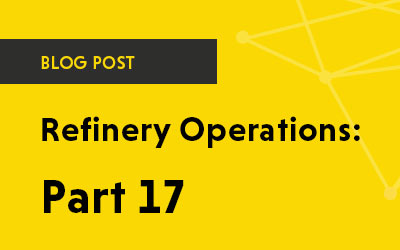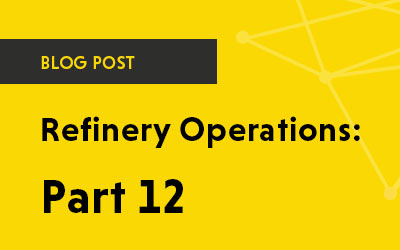Part 13
As the popularity of the automobile increased during the early 1900’s, the demand for the gasoline portion of a barrel of oil proportionally increased. It quickly became apparent that meeting the market demands for straight-run gasoline would result in a glut in the marketplace of the heavier fuel oil crude fractions. In order to increase gasoline products catalytic cracking is used.
In response to how to make use of the heavier hydrocarbon streams to increase the amount of gasoline range product available, several “cracking” techniques were developed. The most popular of the techniques is catalytic cracking, also called “cat” cracking.
Cracking is a process in which large hydrocarbon molecules are broken up “cracked” into smaller, more valuable hydrocarbon molecules. As the name implies, the catalytic cracking process takes place in the presence of a catalyst. The catalyst promotes breaking of the large molecules in a certain way that maximizes the yield of gasoline. Ideally, all of the “cat-cracked” product would be in the gasoline range, but the technology is not that capable. Cat cracking produces a full range of hydrocarbons, from methane to residue.
The feed to the cat cracker is typically gas oil or naphtha. The trend in the design of modern cracking units is the ability to include the residuum as a part of the cracker feed. The residue produced by the catalytic cracker is recycled back into the feed stream. This recycling of the residue is called “recycling to extinction”.
Catalytic cracking consists of three major processes:
- Reaction
- Regeneration
- Fractionation
In the reaction step, the hydrocarbon feed is contacted by the catalyst at a high temperature (about 900 F, 482 C) and the cracking reaction takes place. During cracking, coke is formed. The coke will coat the catalyst preventing it from promoting the cracking reaction. The catalyst is renewed by burning off the coke deposits from the catalyst surface during regeneration. The cracked hydrocarbons are separated using conventional fractionating equipment.
There are three basic types of catalytic crackers:
- Fluid bed
- Moving bed
- Fixed bed
The names of the catalytic cracker styles describe the catalyst bed used. Fluid bed catalytic cracking (FCC) is the most popular design in use today. In the FCC unit, the catalyst is a finely divided powder. When the catalyst is fluidized or “fluffed-up” with air or hydrocarbon vapor it behaves like a fluid and can be moved through pipes and valves.
The catalyst in a moving bed catalytic cracker is in the form of beads or pellets. A mechanical means must be used to move the catalyst from one part of the process to another. In newer plants, air (lift air) or combustion gases from the catalyst regeneration are used to move the catalyst from one place to another.
In FCC and moving bed cracking, catalyst is regenerated in an area separate from the reaction. The catalyst has to be moved by some means from the reactor to the regeneration area. In fixed bed designs, the catalyst is not moved. The equipment consists of a series of reactor vessels containing the catalyst bed. Some of these reactors will be on-line producing cracked hydrocarbons while others will be off-line having the catalyst regenerated.
Fluid Catalytic Cracking
Today, FCC is the most popular of the catalytic cracking processes. FCC units consist of three primary pieces of equipment:
- The reaction chamber in which the hot feed is mixed with the catalyst and the cracking reactions take place
- The regenerator in which the catalyst is regenerated by burning the coke produced in the reactor from its surface
- The fractionator where the cracked hydrocarbons are separated into useful products.
Most FCC units can be described as being one of three general designs: a stacked design, a side-by-side design, or a riser/reactor design. The terms stacked and side-by-side refer to the relationship of the reactor to the regenerator. In the riser/reactor design, there is no reactor vessel in the conventional sense. The cracking reaction takes place in a riser pipe which connects the regenerated catalyst storage area and the catalyst/hydrocarbon separation equipment.
Side-By-Side Design
In figure 1 below is an illustration of the FCC unit licensed by ExxonMobil co. The design consists of a reactor vessel built along side of a catalyst regenerator with long radius U-bend piping connecting the two vessels.

The process is based on a continuous circulation of the catalyst between the reactor and the regenerator. The regenerated catalyst flows from the regenerator standpipe into the bottom of the reactor through a long radius U-pipe. The hydrocarbon feed is introduced into the catalyst flow in this U-pipe. Heat causes the feed to expand or vaporize and fluidize the catalyst. The catalyst and hydrocarbon feed then enter the reactor where the cracking reactions are completed. In practice, most of the cracking of hydrocarbons is accomplished in the U-pipe prior to entering the reactor.
The cracked hydrocarbons are separated from the catalyst in cyclone separators which are internal to the reactor, and then charged to the fractionating column. The hydrocarbons are separated into the various streams in the fractionator. The fractionator bottoms are known as “cycle oil” and are reintroduced into the feed stream and recycled to extinction.
The spent catalyst that is coated with coke gravity flows through a steam stripping section located below the reactor. In the steam stripper, residual hydrocarbons are removed from the catalyst.
After steam stripping, the catalyst is re-fluidized by auxiliary air and forced into the regenerator. Combustion air is introduced into the regenerator and the coke is burned off of the catalyst.
The combustion gases exit the top of the regenerator, after passing through cyclone separators to remove the catalyst fines. The combustion gases are used as fuel for steam generation in CO boilers. The regenerated catalyst enters a standpipe, in the bottom of the regenerator, before being recycled back to the reactor.
For the sake of brevity, I will not go over the stacked, riser/reactor, moving bed nor the fixed bed design process flows. But, you get the scheme of what happens in catalytic cracking from the above descriptions.
Types of Fouling
Operational deposits on the hydrocarbon side of a cracking unit will typically be a mixture of organic and inorganic materials consisting of iron, sulfates and sulfides. The consistency of these deposits ranges from hard coke-like material to what can be described as a sludge. The coke deposits will usually be found in the heat exchanger bundles in the cycle oil line between the bottom of the fractionator and the reactor. Coke deposits may also be found in the feed stream pre-heat furnace. Hydroblasting is probably the most effective means of removing the coke. No solvent system has been found that is effective in removing the coke.
The fouling on the water side of the heat exchangers will be primarily water-borne scales and corrosion products. Depending on the water source, there are many techniques for the chemical removal of these types of deposits that are effective, efficient and cost tolerant. The air side of the fin-fan coolers will become fouled with a soot-like coating of ordinary dirt. This type of fouling can usually be removed by spray washing with a hot neutral detergent-based solution containing a suitable surfactant.
The boilers will become fouled with the same type of deposits that can be found in conventional boilers. Co and waste heat boilers are susceptible to fouling by operational deposits. These units must be periodically cleaned just like any other type of boiler.
Lube and seal oil systems are very important in a cracking unit. In addition to the uses on pumps and boilers. There will be large systems for the air compressors and cyclone separators that are typically thousands of gallons in system volume. While these systems do not require to be cleaned often, they are occasionally cleaned. Cleaning can be accomplished by the processes typical of preoperational cleaning techniques. Of interest, because of the extensive amount of temporary piping that is required to form a circulation loop, vapor phase cleaning with the appropriate chemical additives is a good candidate for the cleaning process.
The fractionator and the associated equipment will contain fouling similar to that found in the crude plant distillation process. The columns will require hazardous vapor removal for light-end hydrocarbons such as benzene and de-oiling. Additionally, since the catalytic reactions of the FCC unit result in the formation of unsaturated compounds (alkenes), you also encounter low-molecular weight polymers and varnish that can deposit inside the fractionator and heat exchange equipment.
Lastly, the FCC unit also has a nasty vessel called a Slurry Settler tank. This vessel collects catalyst fines that have been suspended in slurry oil from the process. The separated slurry oil is decanted from the top of the vessel for re-use while the catalyst fines precipitate inside of the slurry tank forming a hard, concrete-like solid. The catalyst solids are impregnated with hydrocarbons that make the catalyst fines a hazardous waste that carries an EPE K hazardous waste code. This material is expensive to dispose.
Recent develops in extraction chemistry have resulted in a process and chemical products that are effective in removing low PPM-levels of the numerous constituents that comprise the K-code and allow for a non-hazardous disposal of the spent catalyst fines through conventional non-hazardous waste disposal facilities. Imagine the savings to be gained in non-hazardous disposal.
Conclusions
Through these conversations about refinery operations, we have tried to remove the sales pitch component, even though this is not completely possible. Our goal is to bring to your attention to new developments in the industry and the field of chemistry that will prove beneficial in your operations. Chemistry is dynamic and ever learning new ways to address concerns that you encounter every day.



